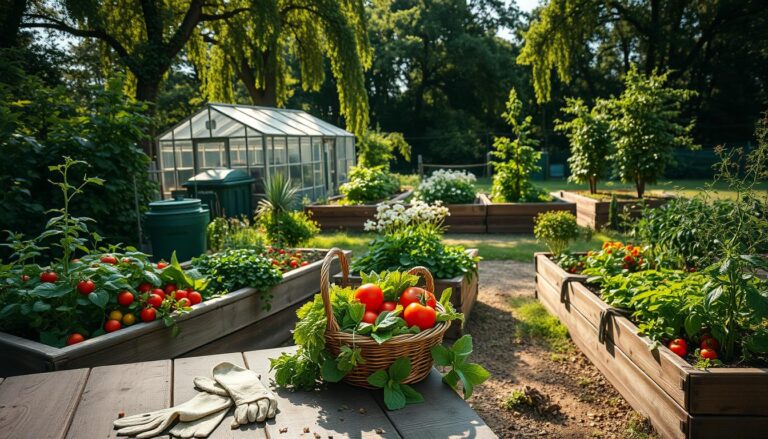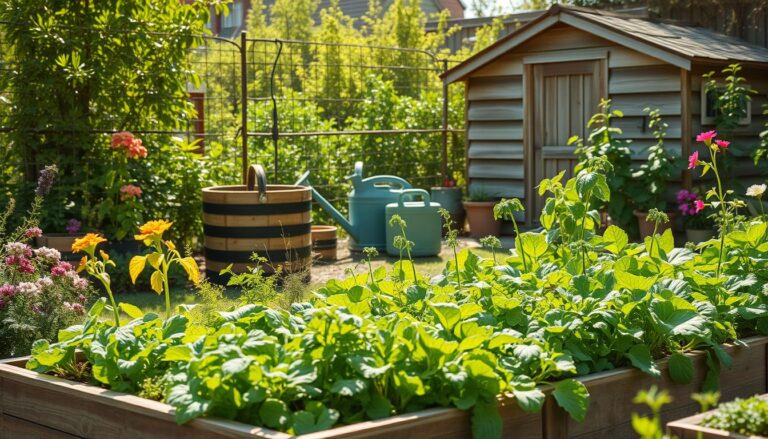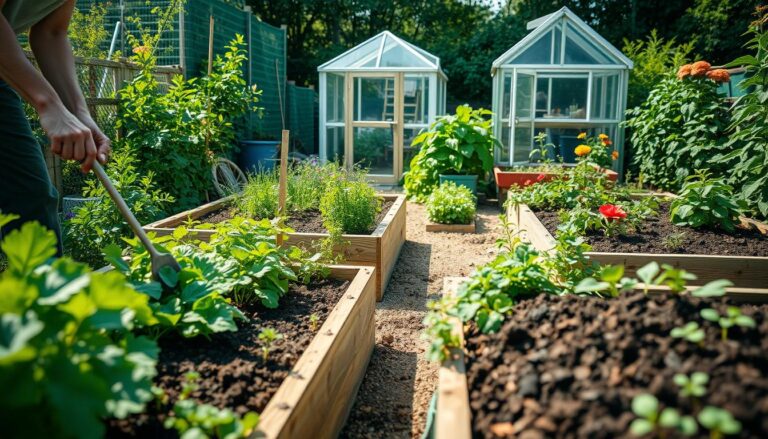Starting an organic farm is a rewarding journey. It lets you grow fresh food for your family and community. It also supports sustainable farming practices.
This guide will help you start a thriving organic farm. We’ll cover key steps like assessing your resources and planning your farm. By the end, you’ll be ready to grow a successful and sustainable farm.
Understanding Organic Farming Principles
Organic farming is more than a method; it’s a way of life. It focuses on creating a balanced ecosystem. This includes healthy soil, diverse life, and smart water use.
What Makes Farming “Organic”
Organic farming avoids synthetic fertilizers, pesticides, and GMOs. Instead, it uses natural methods to keep soil fertile and pests away.
Key practices include crop rotation, composting, and natural pest control. These methods improve soil health and make farms more diverse and strong.
Benefits of Organic Farming
Organic farming has many benefits. It improves soil health, boosts biodiversity, and uses water wisely. It also helps the environment by reducing pollution from harmful chemicals.
Common Misconceptions About Organic Farming
Many think organic farming is less productive than conventional farming. But research shows organic farming can be just as good, or even better, when done right.
Some also believe organic farming is too hard. While it may need more labor at first, it can save money in the long run by avoiding synthetic inputs.
The Organic Mindset: Working With Nature
The organic mindset is about working with nature, not against it. It’s about understanding and respecting the natural balance. Techniques are used to enhance this balance.
| Organic Practice | Conventional Practice | Benefit |
|---|---|---|
| Crop Rotation | Monocropping | Improved Soil Health |
| Composting | Synthetic Fertilizers | Reduced Pollution |
| Natural Pest Control | Chemical Pesticides | Increased Biodiversity |
Assessing Your Resources and Goals
Before starting an organic farm, it’s key to know your resources and goals. This step helps build a strong foundation. It ensures your farm is based on what you can do and what you want to achieve.
Evaluating Your Land and Climate
First, check the land you have for farming. Look at soil quality, drainage, and sunlight. Climate is also important. Knowing the weather, frost dates, and natural disasters helps decide what to grow and when.
Setting Realistic Farm Goals
Setting goals is crucial for your farm’s success. Decide what you want to do in the short and long term. Do you want to grow food for your family or sell it? Clear goals help decide on farm size, crops, and marketing.
Time and Financial Commitment
Organic farming needs a lot of time and money. Check your finances to see how much you can spend. Think about seed, equipment, labor, and certification costs. Also, consider how much time you can give to farming, including planning and marketing.
Personal Skills Assessment
Lastly, check your skills and knowledge. Organic farming needs many skills, from growing crops to managing a business. Find any skill gaps and learn from others. You can get advice from experienced farmers, attend workshops, or join farming groups.
| Resource | Assessment Criteria | Action Plan |
|---|---|---|
| Land | Soil quality, drainage, sunlight | Conduct soil tests, improve drainage if necessary |
| Climate | Weather patterns, frost dates | Choose climate-resilient crops, plan for frost protection |
| Financial | Initial investment, ongoing costs | Create a budget, explore funding options |
“The way we farm is a reflection of our values and our commitment to the land and our community.” – Unknown
How to Start a Small Organic Farm: Planning Your Operation
To start a thriving organic farm, you need to plan carefully. This step involves several key actions. They will guide your decisions as you start your organic farming journey.
Creating a Farm Business Plan
A detailed farm business plan is crucial. It outlines your goals, how you’ll produce, market, and finance your farm. A good plan helps you get funding, make smart choices, and track your progress.
Determining Your Farm Size and Scale
The size of your farm depends on what you have: land, money, and people. Start small and grow as you learn and build your market.
Choosing Your Farming Focus
Choosing what to grow or raise is key. Your choices should match market demand, your skills, and your land and climate.
Vegetables and Fruits
Growing veggies and fruits can be profitable. Pick crops that are in demand and have good prices. Think about the season, pests, and soil needs.
Herbs and Specialty Crops
Herbs and specialty crops like microgreens or edible flowers can bring in good money. Look into market demand and growing needs for these crops.
Small-Scale Livestock
Raising small animals like chickens or rabbits adds variety and income. Make sure you have the right setup and know-how to care for them.
By planning well, you can build a sustainable and profitable organic farm. Keep these important factors in mind:
- Market demand: Know what people want in your area.
- Resource availability: Check your land, money, and people.
- Expertise: Think about your farming knowledge and experience.
Legal Requirements and Organic Certification
Knowing the legal rules and how to get certified is key for organic farming success. Starting your small farm business means you need to follow these rules. This helps you avoid problems and make sure you’re doing things right.
Understanding USDA Organic Standards
The USDA Organic Standards set the rules for what’s considered organic. They cover things like soil quality, pest control, and keeping records. It’s important for organic farming for beginners to know these standards well.
Organic farming doesn’t allow synthetic fertilizers, pesticides, or GMOs. Instead, farmers use natural ways to keep soil healthy and pests away.
The Certification Process and Timeline
Getting certified organic involves several steps like applying, getting inspected, and having your application reviewed. It usually takes a few months to a year. Start planning early to fit this into your farming schedule.
Permits and Licenses for Small Farms
Small farms also need different permits and licenses to run. These might include sales tax permits, business licenses, and environmental permits. It’s important to find out what your state and area need.
Record-Keeping Requirements
Keeping accurate records is very important in organic farming. You’ll need to keep track of soil tests, crop rotation, pest control, and sales. Good records show you follow USDA Organic Standards and help with your certification.
| Record Type | Description | Retention Period |
|---|---|---|
| Soil Testing | Results of soil tests for nutrient content and contaminants | 5 years |
| Crop Rotation | Details of crop rotation plans and implementation | 3 years |
| Pest Control | Methods used for pest control, including organic-approved treatments | 3 years |
By following the legal rules and getting certified, you can build a successful small farm. As Rodale Institute says, “Organic farming is more than avoiding synthetic chemicals. It’s about working with nature in a holistic way.”
Finding and Preparing Your Land
Finding the right land is key to starting a successful organic farm. It’s not just about having land. It’s about having land that supports your farming goals.
Land Selection Criteria
When looking for land, several factors are important. Soil quality is crucial for healthy crops. Look for land with rich, fertile soil full of life.
Also, check the land’s history. Avoid areas with chemical contamination or intensive farming that has harmed the soil.
Water Access and Management
Having enough water is essential for farming. Check the land’s water resources, like rainfall and irrigation. Efficient water management is key to conserve water and keep your crops moist.
Initial Site Preparation
After choosing your land, prepare it well. Clear debris, till the soil, and add organic amendments to improve soil fertility. This hard work is necessary for a good growing environment.
Sustainable Infrastructure Planning
Planning for sustainable infrastructure is crucial for your farm’s success. Build or renovate structures like barns and greenhouses using eco-friendly materials. Also, plan for efficient pathways, fencing, and other infrastructure to support your farm.
By considering these factors, you can lay a solid foundation for your organic farm. This will help you succeed in starting a small organic farm and follow important tips for starting a small farm.
Building Healthy Soil for Organic Production
Healthy soil is key to organic farming. It lets farmers grow strong crops naturally. A good soil ecosystem has many beneficial microbes, is well-aerated, and holds water well. These are all important for plants to grow well.
Soil Testing and Analysis
To start, you need to know what your soil is like. This means testing and analyzing it. Soil testing kits give quick results. Labs can give more detailed info.
Organic Soil Amendment Methods
After testing, you can start making your soil better. You can add compost, manure, or green manure. These improve soil health and help the whole ecosystem.
Composting Techniques
Composting is a big part of organic farming. It turns waste into something valuable. To compost well, mix “green” and “brown” materials, keep it moist, and aerate it often. This makes compost that makes soil better.
Cover Cropping and Green Manures
Cover cropping and green manures also help soil. They reduce erosion, improve nutrient cycling, and help insects. Legumes, for example, add nitrogen to the soil naturally.
No-Till and Minimal Tillage Approaches
No-till or minimal tillage are good for soil. They reduce soil disturbance, keep organic matter, and help biota. This also cuts down on erosion and keeps water in the soil, making farming more sustainable.
Organic farmers use these methods to create healthy soils. These soils support strong crops and a sustainable farm. As an organic farming guide says, healthy soil is a living system that needs care and attention.
Essential Equipment and Tools
Getting the right farm equipment is key to a successful organic farm. Knowing the basic tools and equipment is crucial for managing your farm well.
Basic Farm Equipment for Beginners
Starting a farm can feel overwhelming, especially when it comes to equipment. But, you don’t need to buy everything at once. Begin with the basics like shovels, rakes, and hoes. These tools are vital for planting, weeding, and harvesting.
Hand Tools vs. Machinery
Choosing between hand tools and machinery depends on your farm’s size. For small farms, hand tools are a good start because they’re affordable and effective. But, as your farm grows, you might need machinery like tractors and tillers to work more efficiently.
Storage and Infrastructure Needs
Good storage and infrastructure are essential for keeping your produce and equipment in top shape. You’ll need barns for storing tools and produce. Also, a reliable irrigation system is important for managing water effectively.
Equipment Sharing and Cooperative Options
Equipment sharing or joining a cooperative can be a smart move for small-scale farmers. It helps you access the machinery you need without a huge upfront cost.
| Equipment Type | Initial Cost | Maintenance Cost |
|---|---|---|
| Hand Tools | Low | Low |
| Machinery (Tractors, Tillers) | High | Medium to High |
| Irrigation Systems | Medium | Low to Medium |
Understanding your equipment needs and looking into sharing or cooperatives can help you manage your organic farm well. This approach can boost your farm’s productivity.
Selecting and Growing Organic Crops
Picking the right crops is key to a successful organic farm. It’s important to choose crops that fit your local climate and soil. This is a crucial step for organic farming for beginners.
Choosing Suitable Crops for Your Region
Think about temperature, rainfall, and soil type when picking crops. Find out which crops grow best in your area. For example, leafy greens love cooler weather, while tomatoes and peppers need it warmer.
Crop Rotation and Diversity Planning
Rotating crops keeps the soil healthy and fights pests and diseases. Mix different crops with different needs and growth patterns. This keeps the soil fertile and structured.
Seed Selection and Sourcing
Pick high-quality seeds for organic farming. Look for seeds from trusted suppliers who focus on organic options. This ensures your crops are right for your area and meet organic standards.
Seasonal Planning and Planting Schedules
Make a planting schedule for each season to boost your farm’s output. Know the frost dates, growing seasons, and best planting times for your crops. This planning maximizes your growing season.
Irrigation Systems for Organic Farms
Good irrigation is essential for healthy crops. Use drip irrigation or soaker hoses to water roots directly. This saves water and cuts down on fungal diseases.
| Crop | Irrigation Needs | Seasonal Considerations |
|---|---|---|
| Tomatoes | High | Warm season |
| Leafy Greens | Moderate | Cool season |
| Peppers | High | Warm season |
By planning your crops, rotation, and irrigation, you can build a strong and diverse organic farm. It will thrive in your local conditions.
Natural Pest and Weed Management
Keeping a balanced ecosystem on your small organic farm is key. It’s important for your crops’ health and the farm’s sustainability.
Preventative Pest Control Strategies
Stopping pests before they start is vital in organic farming. You can do this by rotating crops, keeping soil healthy, and using barriers. For example, row covers keep flying insects away from your crops.
Crop rotation is great because it stops pests from targeting the same crops. By changing what you grow, you lower the chance of pests taking over.
Organic Weed Management Techniques
Weeds steal water, nutrients, and light from your crops. Organic farmers use mulching, hand weeding, and cover crops to fight weeds. Mulching also keeps the soil moist and controls its temperature.
Beneficial Insects and Companion Planting
Beneficial insects like ladybugs and lacewings eat pests. Planting them with your crops can help control pests. For instance, marigolds with tomatoes can keep nematodes away.
| Companion Plant | Benefit | Example |
|---|---|---|
| Marigold | Repels nematodes | Tomatoes |
| Basil | Repels aphids and mites | Peppers, eggplants |
| Nasturtium | Repels aphids, whiteflies | Cucumbers, squash |
Organic-Approved Treatments and Products
If prevention fails, organic farmers use approved treatments. These include neem oil, diatomaceous earth, and insecticidal soaps. It’s important to pick products that are organic certified to keep your farm organic.
Using these natural methods helps protect your crops and supports a healthier ecosystem. This way, your farm is not only sustainable but also follows the principles of starting a small farm business.
Marketing and Selling Your Organic Produce
A good marketing plan is key to selling your organic produce. You need to know the marketing strategies for small organic farms.
Direct Marketing Strategies
Direct marketing helps you sell directly to customers. This way, you can make more money and gain loyal customers. Here are some direct marketing strategies:
- Joining Farmers Markets lets you show off your products and talk to potential buyers.
- Starting Community Supported Agriculture (CSA) programs means regular deliveries of fresh produce to customers.
- Running Farm Stands and U-Pick Operations lets customers buy produce right from your farm.
Farmers Markets
Farmers markets are great for showing off your products and building a community. To do well, make your display appealing and talk to customers.
Community Supported Agriculture (CSA)
CSA programs let customers buy a share of your farm’s produce regularly. This helps you earn a steady income and keeps customers coming back.
Farm Stands and U-Pick Operations
Farm stands and U-Pick operations let customers visit your farm to buy fresh produce. It’s a good way to make money and teach people about your farming methods.
Building Your Farm Brand
Creating a strong brand is important to stand out in the market. Highlight what makes your farm unique, like organic farming and local products.
Pricing Your Organic Products
Setting the right prices is crucial for making a profit. Think about your costs, what people want to buy, and what others are charging.
Online Marketing for Small Farms
In today’s world, having an online presence is a must. Use social media and make a website to reach more people and promote your products.
Conclusion
Starting a small organic farm takes a lot of effort and a desire to learn. This guide has shown you the key steps to start a successful farm. By learning about organic farming, checking your resources, and planning, you’re ready to go.
Remember, every farm is different, so be ready to adjust. Work on making your soil healthy, pick the right crops, and use natural ways to control pests and weeds. With hard work and the right advice, you can make a farm that’s good for the planet and profitable.
Stick to this guide and keep your goals in mind. You’re on the path to a successful small organic farm. For more tips and resources, check out the USDA’s National Organic Program.
FAQ
What are the initial steps to start a small organic farm?
How do I assess if my land is suitable for organic farming?
What is the importance of creating a farm business plan?
How do I choose the right crops for my organic farm?
What are the benefits of crop rotation in organic farming?
How can I manage pests and weeds organically?
What are the key factors to consider when marketing my organic produce?
How do I obtain organic certification for my farm?
What are some sustainable farming methods I can adopt?
How can I plan for the financial sustainability of my small organic farm?

Sortemdia nasceu com o propósito de trazer alegria e oportunidades para todos por meio de sorteios gratuitos de prêmios incríveis. O site tem como missão oferecer experiências acessíveis, divertidas e justas para quem deseja concorrer a produtos, serviços e brindes sem pagar nada por isso. Acreditamos que a sorte pode bater à porta de qualquer pessoa — e no Sortemdia, ela pode chegar com apenas um clique.



